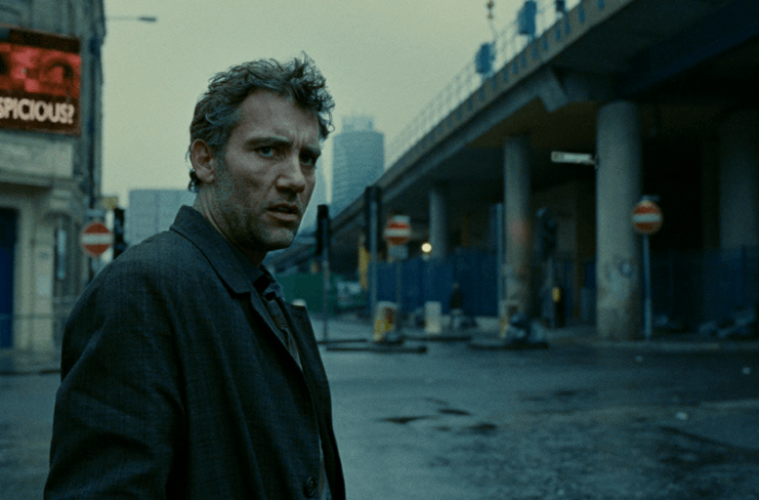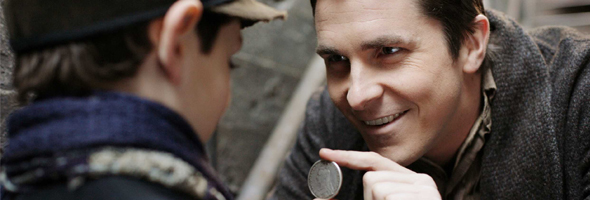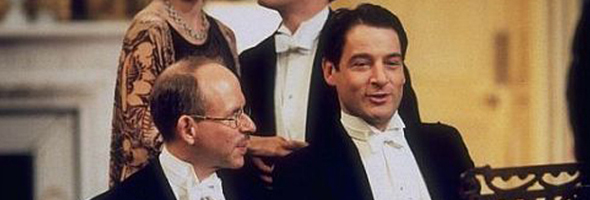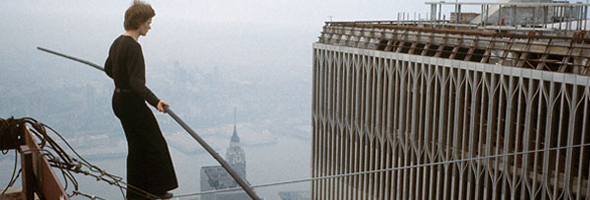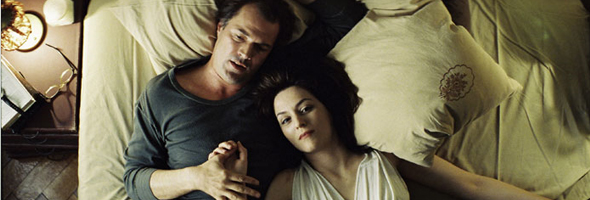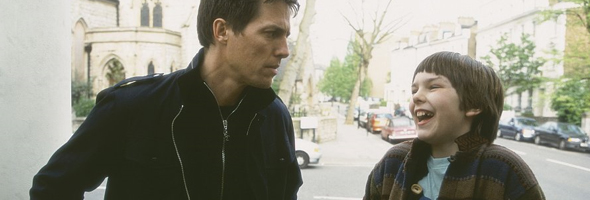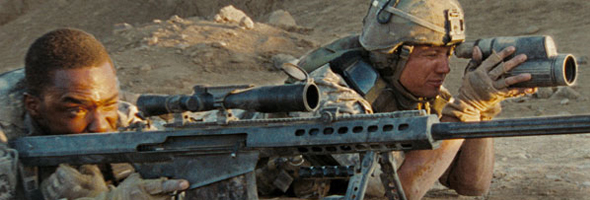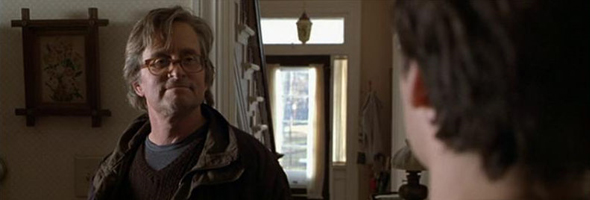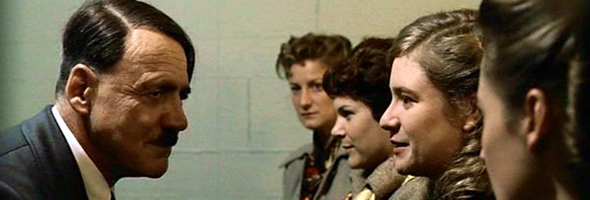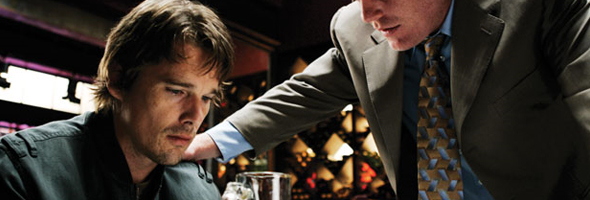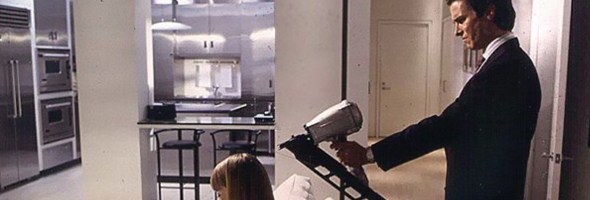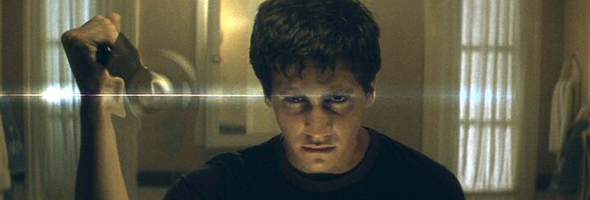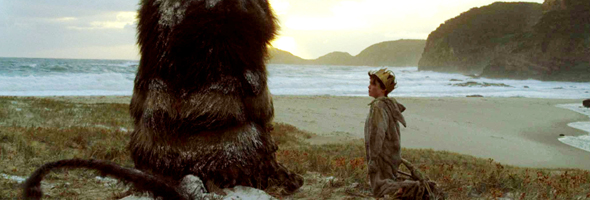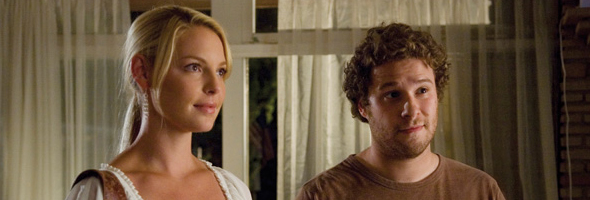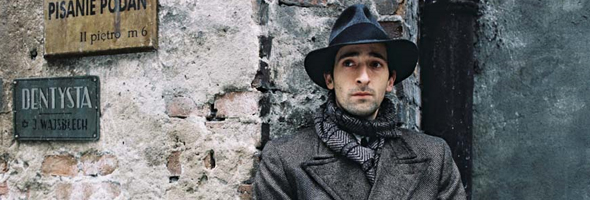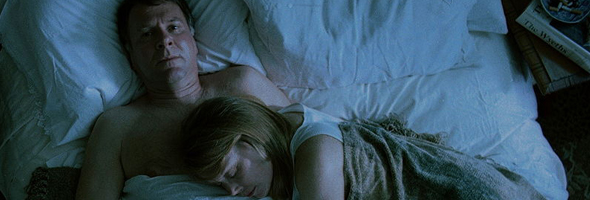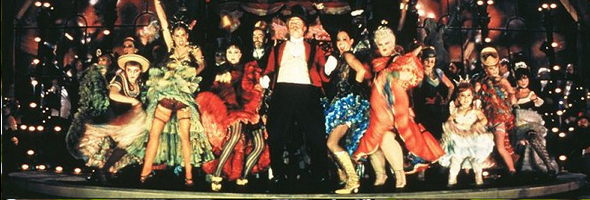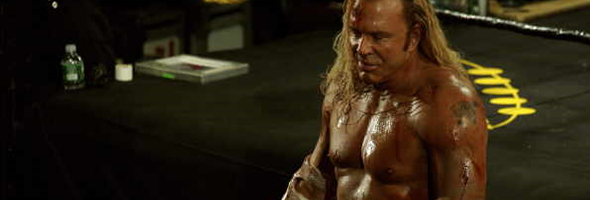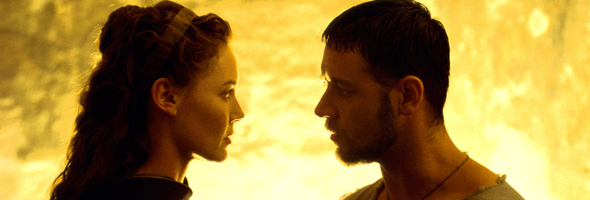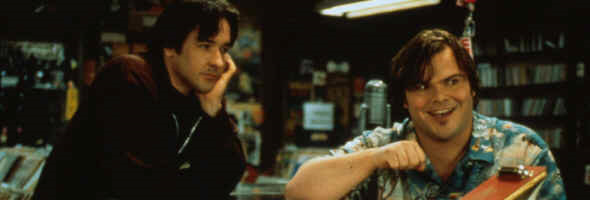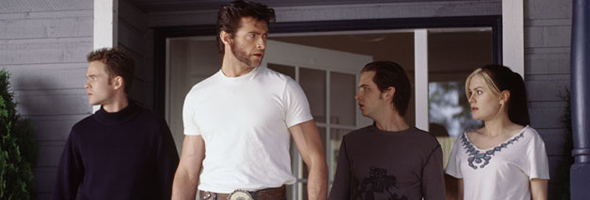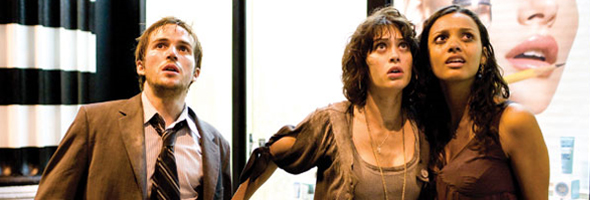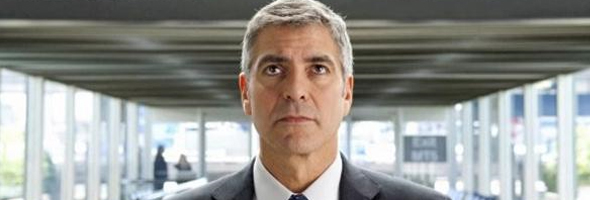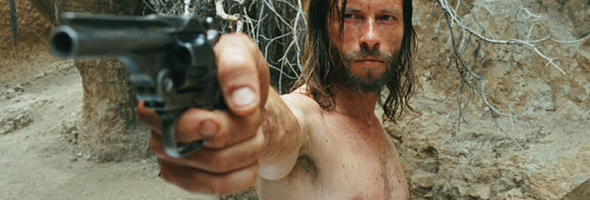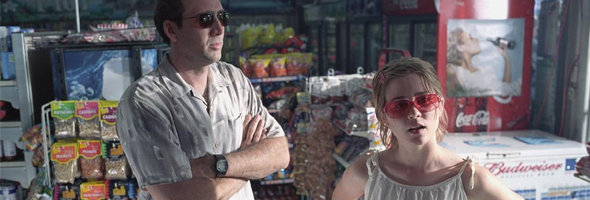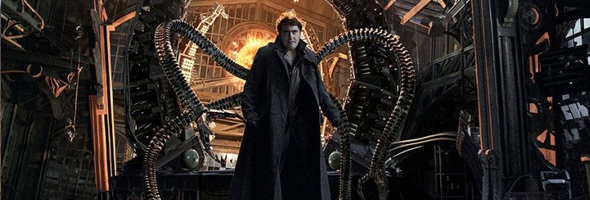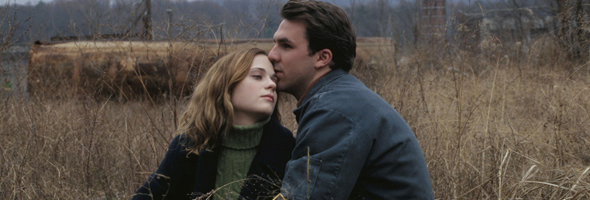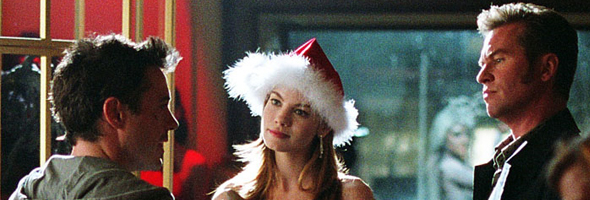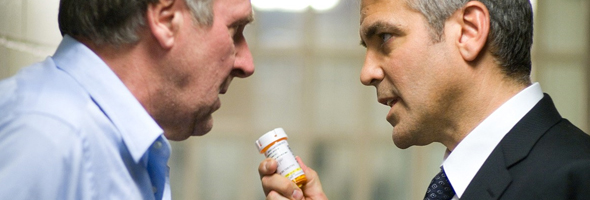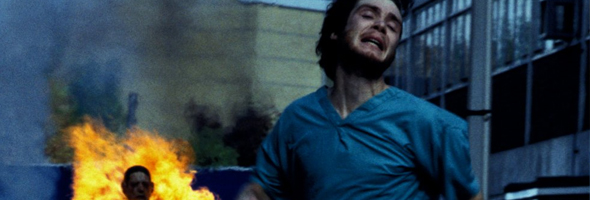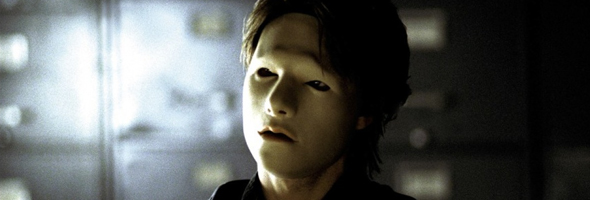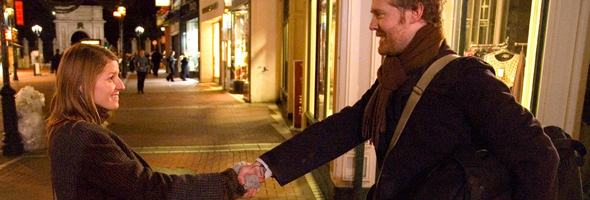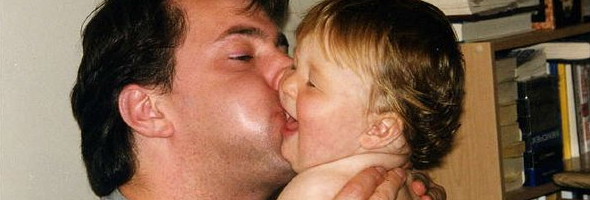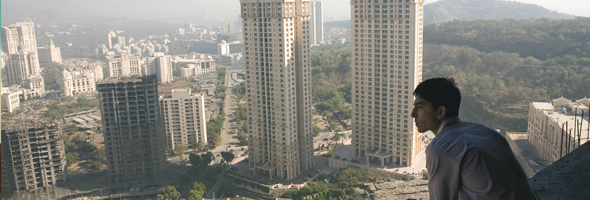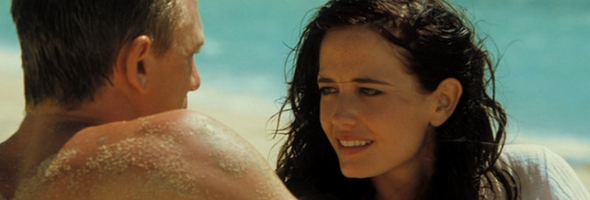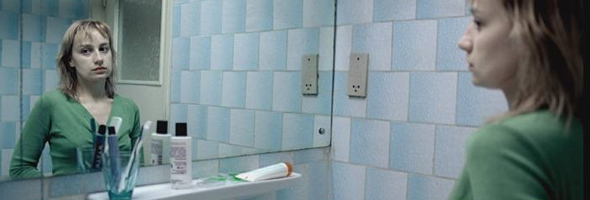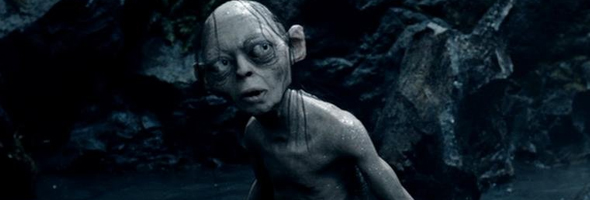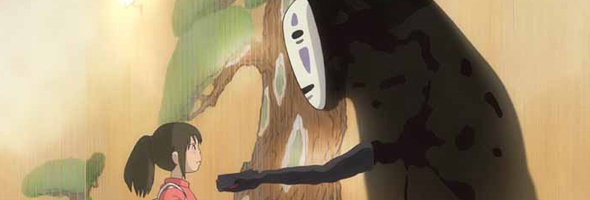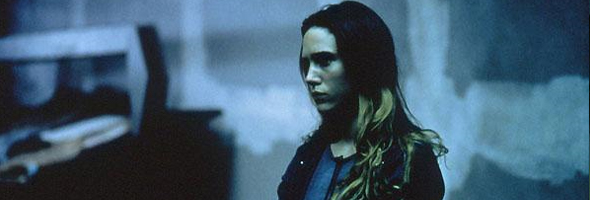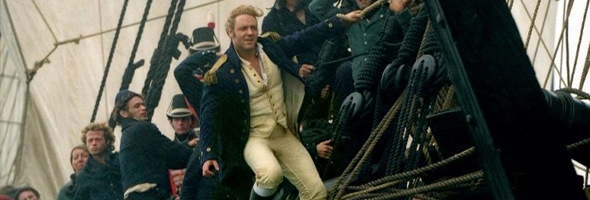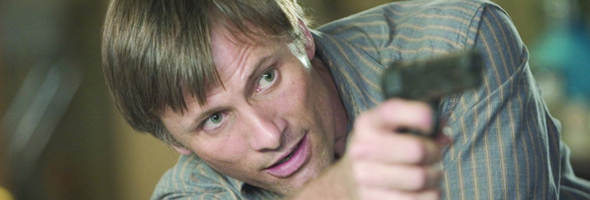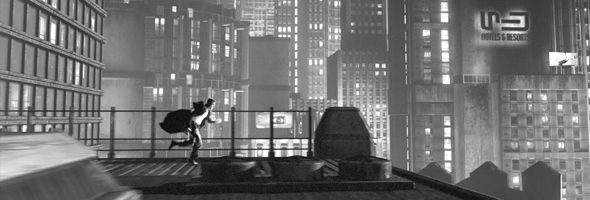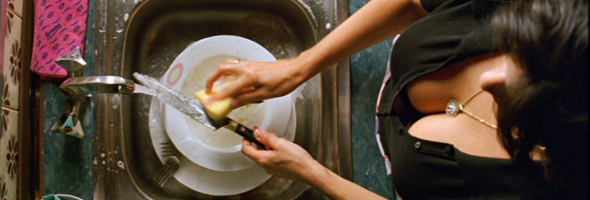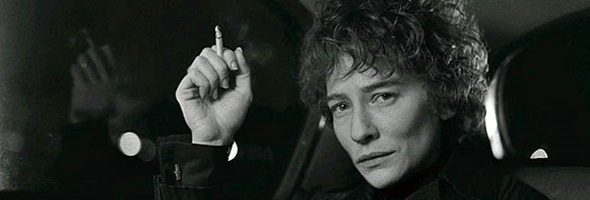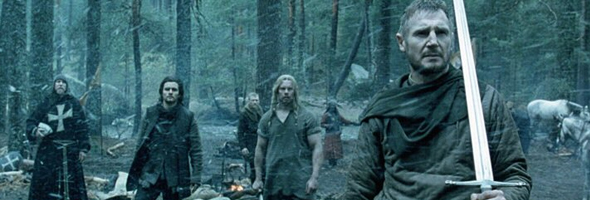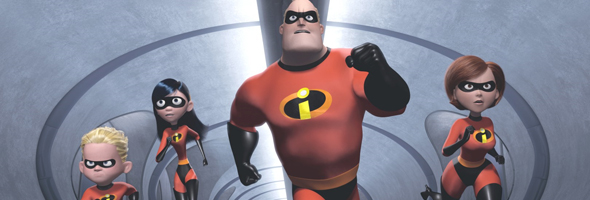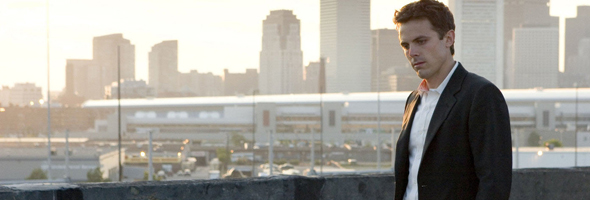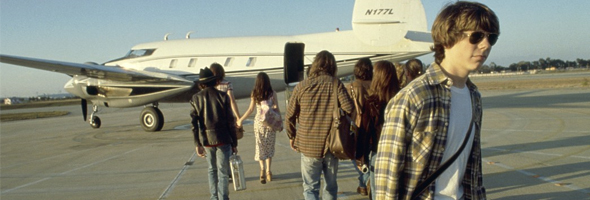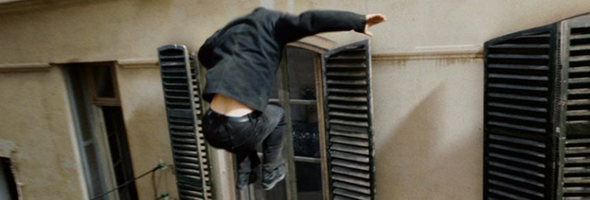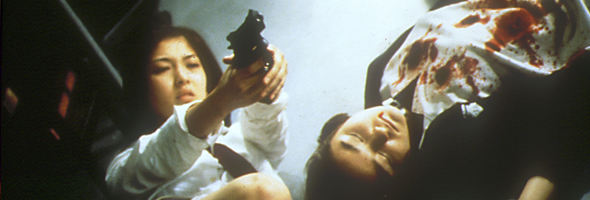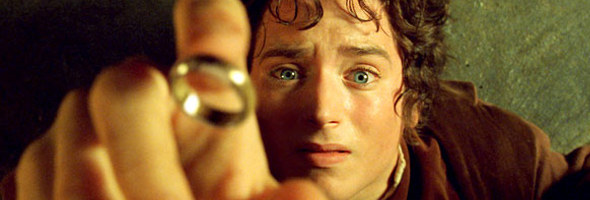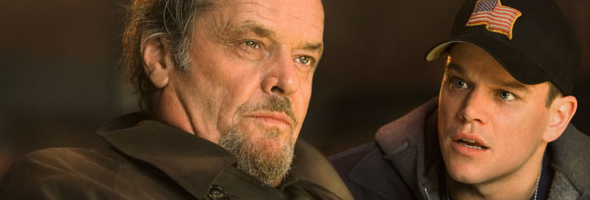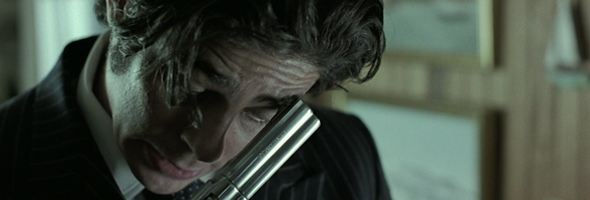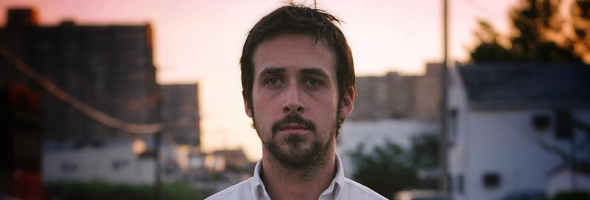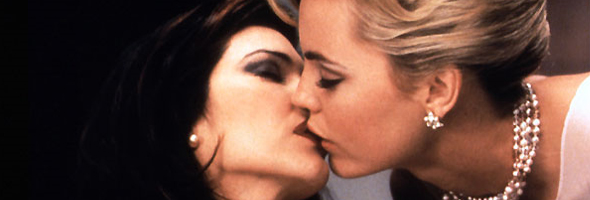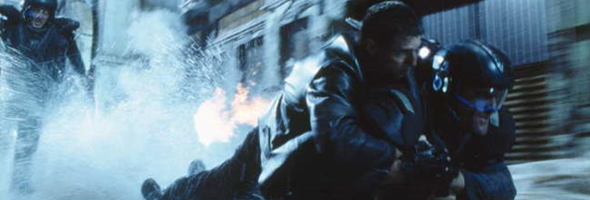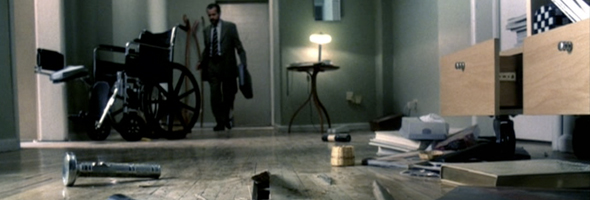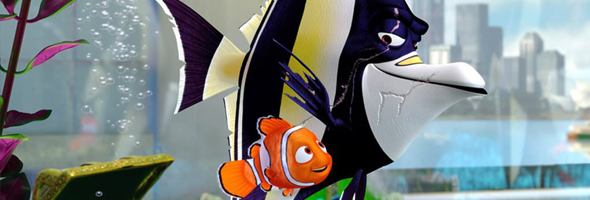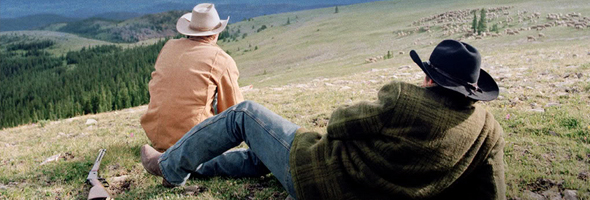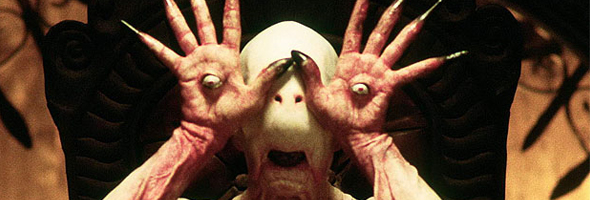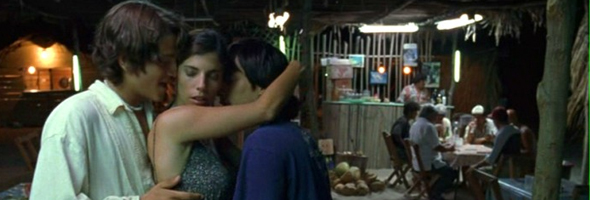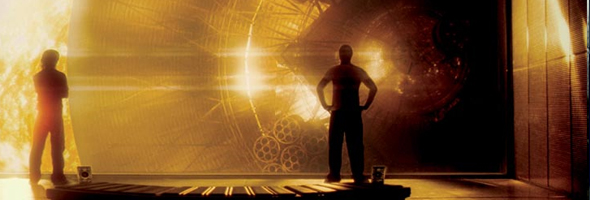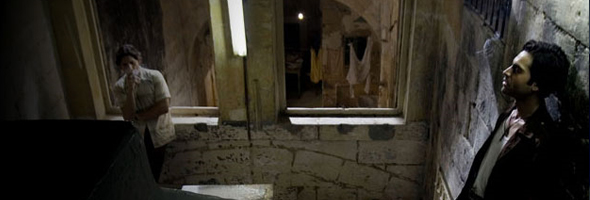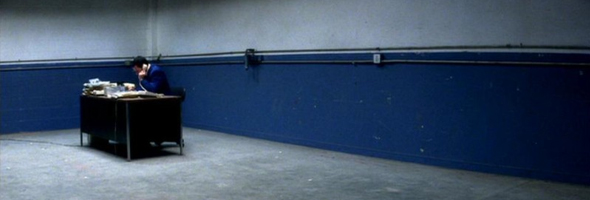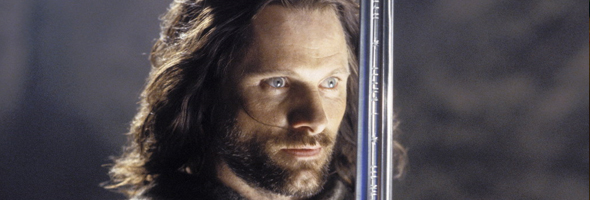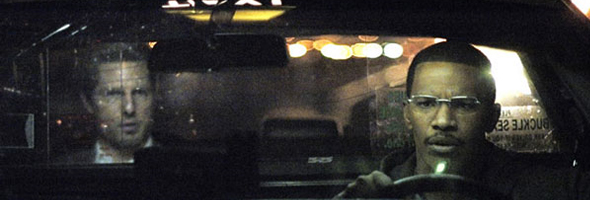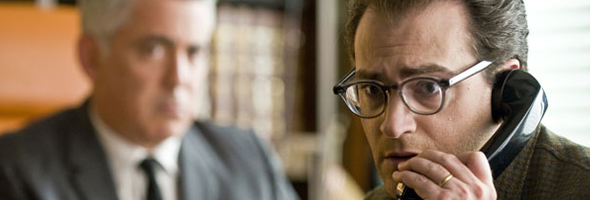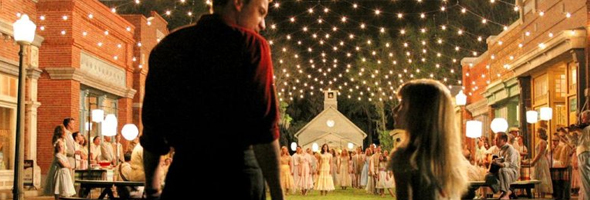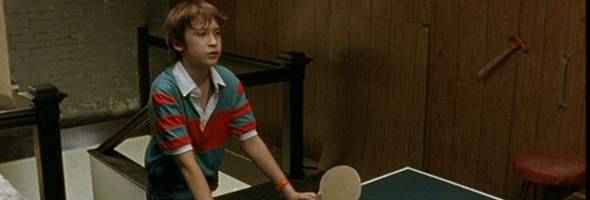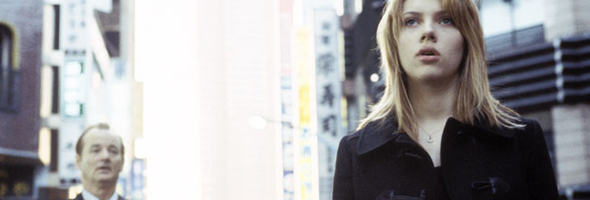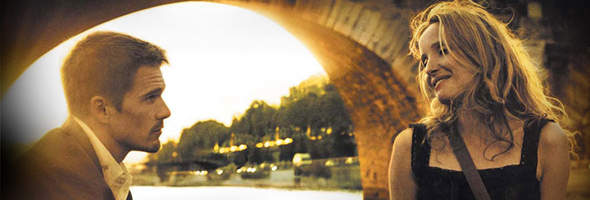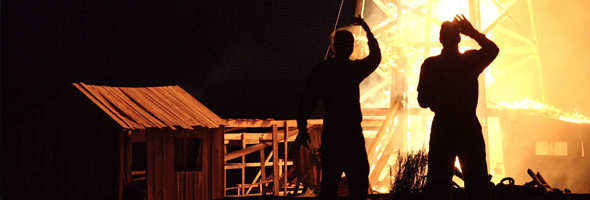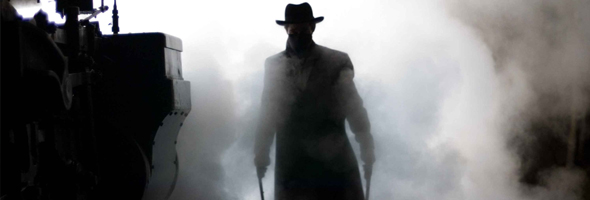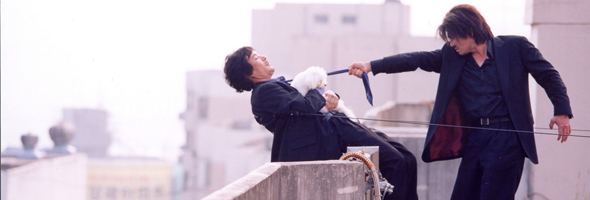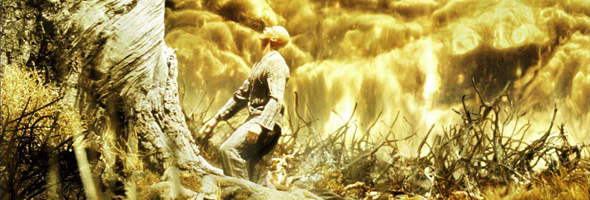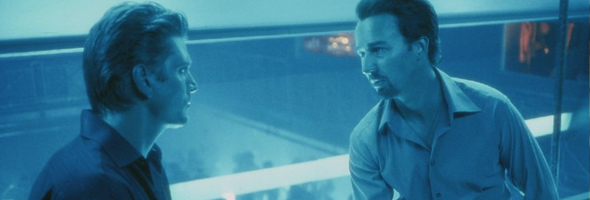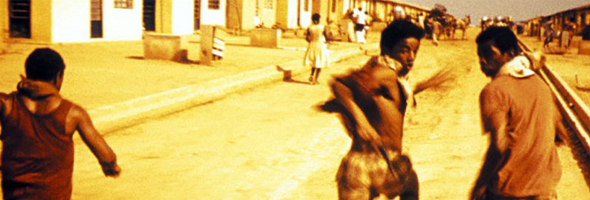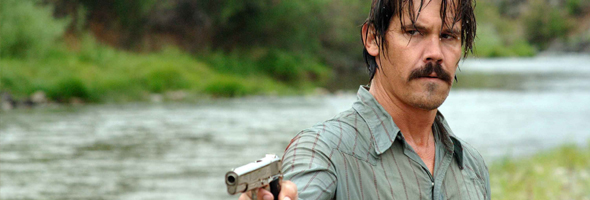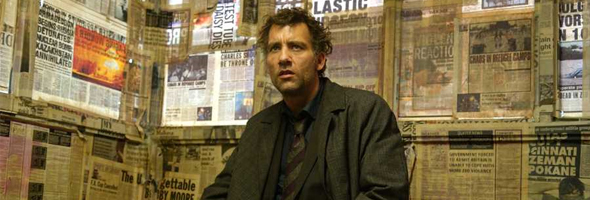For the past few months here at The Film Stage we have had endless debates on the 100 films that defined the decade. After many late nights whittling the list down and some films that hurt to let go, we have landed on 100 films that we believe everyone should see and share. The order isn’t as important as what the list contains; 100 films that changed the way we view the world and how we lived our lives during the past 10 years and undoubtedly well into the next decade and beyond.
100. The Prestige (Christopher Nolan, 2006)
After dissecting the nature of paranoia (Following), the nature of memory (Memento) and the nature of guilt (Insomnia), writer/director Christopher Nolan dissected the nature of lying in this mini-masterpiece about magicians and the depths of each performance. Both Hugh Jackman and Christian Bale rise to a script that is, itself, a magic trick. And, like all great tricks, one worth getting swept up in again and again. – Dan M.
99. Gosford Park (Robert Altman, 2001)
It’s Clue with England’s most accomplished, most refined actors, plus a dynamite, dialogue-driven screenplay by Julian Fellowes from an idea by late master Robert Altman and the always reliable Bob Balaban. At once a satire of Hollywood (both now and then), a mockery of the upper class and a fun romp full of witty dialogue in darkly lit hallways, it’s certainly Altman’s best of the decade and one he will be always remembered for. – Dan M.
98. Man on Wire (James Marsh, 2008)
An amazing documentary chronicling tightrope-walker Philippe Petit’s meticulously-calculated, illegal and purely insane feat of sneaking to the top of the World Trade Center in New York City in 1974 and doing his tightrope routine between the two towers. 1350 feet in the air, Philippe successfully accomplishes a nearly unbelievable act while making the journey to that point one of the most interesting heist stories ever told. Touted as the “artistic crime of the century,” Man on Wire is one of the most engaging and enjoyable documentaries ever, let alone the decade. – Addam H.
97. The Lives of Others (Florian Henckel von Donnersmarck, 2006)
I was quite upset when Pan’s Labyrinth lost the Foreign Oscar to this film a few years ago. Then I watched it. This gripping tale of betrayal and fear played out by some of the finest foreign actors around was one of the most memorable films of the decade. Not since The Conversation has surveillance been captured so well. – Jordan R.
96. About a Boy (Chris and Paul Weitz, 2002)
Hugh Grant’s apparently most appealing when he’s a pompous shut-in on the cusp of an emotional breakthrough. This warmhearted comedy from Chris and Paul Weitz is not groundbreaking but its spirit is one of a kind. The chemistry between Grant and then-newcomer Nicholas Hoult is a delight. As a testament to Nick Hornby’s culturally aware books-turned-films, it’s packaged with great music: Badly Drawn Boy’s gentle Brit pop-rock. – Mark M.
95. The Hurt Locker (Kathryn Bigelow, 2009)
The 60’s had Lawrence Of Arabia, the 70’s had Apocalypse Now, the 80’s had Full Metal Jacket, the 90’s had Saving Private Ryan, and, finally, at the tail end of the 00’s one film stood out as THE war film of this past decade. The Hurt Locker is perhaps the best look at the effect on soldiers fighting in the current war against terrorism. The enemy isn’t going to put their body on the line anymore when they can kill you via cell phone. They can get you anywhere at any time. That kind of danger is faceless and without warning. Only those with the bomb detectors can find the answers. – Merrill B.
94. Wonder Boys (Curtis Hanson, 2000)
Blending comedy and drama without blinking whilst allowing Michael Douglas the best performance of his career, director Curtis Hanson’s adaptation of this Michael Chabon novel is bittersweet and melodramatic, just like the writers it examines. Some shrug it off as a mere acting showcase. And while this much is true, there’s great writing courtesy of Steve Kloves and a great soundtrack, of which Bob Dylan is partly responsible. It’s hard to ask for much more than that in a movie about artsy people, for artsy people. – Dan M.
93. Downfall (Oliver Hirschbiegel, 2004)
Adolf Hitler was a terrible and evil man. there is NO doubt about that. What Downfall was able to do was give a unique characterization of this man. Many consider this to be the ultimate movie of Hitler’s third Reich. Every character showed on screen actually existed. Every fight and error shown actually happened. On top of that, we are given emotional insight of what might have gone through Hitler’s mind as his power started to decline. – Hash M.
92. Before the Devil Knows You’re Dead (Sidney Lumet, 2007)
After a string of misses, the legendary Sidney Lumet finally delivered a film that stands next to his early classics. The cast is filled with true pros including Albert Finney, Philip Seymor Hoffman, Ethan Hawke and Morisa Tomei. The ending may go a tad over-the-top, but the extreme nature of these characters makes it all believable. – Jack G.
91. Anchorman (Adam McKay, 2004)
This over-the-top story of an anchorman’s trials to become the best that there ever was certainly moved me to tears… as I fell out of my theater seat laughing insanely. Will Ferrell has never been this funny. With a cast that features the main players of modern comedy, you have to have no soul to not enjoy Ron’s crying, dog loving, rival news fighting, slightly homoerotic trek to the top. – Hash M.
90. American Psycho (Mary Harron, 2000)
A dark, twisted, and hilarious parody on the high-class rich folks from the 80s. Any film in which Jared Leto gets thwacked in the face with an axe by psychopathic Christian Bale is pure gold. This is a truly funny and unsettling must-see. – Jack G.
89. Donnie Darko (Richard Kelly, 2001)
A film student’s wet dream. This is not a back-handed compliment. Ambitious auteur Richard Kelly delivered this little gem as his debut, and he’s yet to find a voice as tight and sound to follow it up with. Featuring a break-out turn by Jake Gyllenhaal as the twist protagonist and great supporting turns from Patrick Swayze and Holmes Osborne (Donnie’s dad), Darko offers twists that don’t feel cheap and long shots that don’t feel (quite) pretentious. Well done, Mr. Kelly. – Dan M.
88. Where the Wild Things Are (Spike Jonze, 2009)
One of the most beautiful and pure films in recent memory, Spike Jonze’s adaptation of Maurice Sendak’s timeless children’s story is an incredible achievement in cinema and a heartfelt journey to the best, and darkest, moments of your childhood. Max is ten years old and the weight of dealing with his family not paying much attention to him pushes him to create a world of monsters to escape to. A world where he is king. Where The Wild Things Are is a short children’s book of only 48 pages and around 340 words total, brilliantly expounded on by Dave Eggers and vividly brought to life by Spike Jonze. – Addam H.
87. Knocked Up (Judd Apatow, 2007)
This is a film that defined (and redefined) several things at the movies: an Apatow-esque film, a man-child, bromances, the R-rated comedy, the accepted running time of a comedy, etc. It also made stars out of Seth Rogen and Katherine Heigl. Luckily, this film is worth all of the reference and all of the praise. – Dan M.
86. The Pianist (Roman Polanski, 2002)
Reading Wladyslov Szpilman’s memoir in high school, I shuttered at the thoughts of a child being beaten to death trying to escape a Jewish ghetto or a paralyzed man being thrown out of a four story window only to have the rest of the family running away while being shot like dogs. Polanski kept every last detail of Szpilman’s life incredibly accurate with appropriately disturbing details. Seldom movies captures the horror and traumatizing actions war makes men do. The Pianist is one of them. – Hash A.
85. The Station Agent (Thomas McCarthy, 2003)
One of the best examples of a small movie doing big things without saying much or even having much to say. Writer/Director Tom McCarthy tells the story of Fin, a dwarf who lives in an abandoned train station and prefers the isolation. This, of course, doesn’t last as he encounters people, both outgoing and troubled, in the form of Bobby Cannavale, Patricia Clarkson and Michelle Williams. Peter Dinklage owns the film as Fin and the rest of the cast is up for the challenge. McCarthy practices the old “less is more” adage here, and you’ll get more than you could ever expect. – Dan M.
84. In the Bedroom (Todd Field, 2001)
Frank is the only son of a normal New England family. Dad is a doctor, Mom is a school teacher and Frank is in his summer break from his first year of college. Frank is in love. Not in love with a fellow college student though. He is in love with an older woman from town with two kids and a violent ex-husband who is still dealing with the not-quite-finished divorce. Soon Frank’s choices bring an unspeakable tragedy to this quaint and simple New England family. Tragedy that leaves the family forever changed. – Addam H.
83. Moulin Rouge (Baz Luhrman, 2001)
Eccentric without apology, director Baz Lurhmann managed to bring together a classical love story, visually-warped cinematography and pop musical numbers to great effect. Whilst directors would go out of their way to remove anything unprofessional from their film, Luhrmann feeds off the amateurish look of his sets and the realistic voices of his actors. Musicals are a rare success but Moulin Rouge was an addictive pleasure to watch repeatedly. – Josie M.
82. Inglourious Basterds (Quentin Tarantino, 2009)
I’ve seen Inglourious Basterds twice now, the first time opening weekend in a packed theater and I waited until it’s release on DVD to catch it again. In the words of David Bowie’s “Cat People,” it had been so long. Watching it again, I was nearly astounded at how much Quentin Tarantino had thought out each line and each character action down to a T. The film is distinctly aware of what we’re watching, and thus the filmmaker at hand has made what is a feast for any film lover who is willing to go along with it. There’s a lot to be said about the movie, in terms of the moral complexity at hand, about Christoph Waltz’s hopefully harrowing (and humorous) supporting performance as Hans Landa, about the ending, of it’s design as a movie itself, and so much more. – Nick N.
81. The Wrestler (Darren Aronofsky, 2008)
The Wrestler is a unique animal. Made with great skill by Darren Aronofsky, whose polarizing previous film The Fountain either worked for you or didn’t. His latest is expertly made, acted to heartbreaking degree by Mickey Rourke in the lead and Marisa Tomei in a supporting role, and says a lot about failed dreams and the attempts to recoup them in any way possible. At the same time, while I recommend it to everybody who can see it or asks about it, it’s also a movie I have absolutely zero desire to ever see again. Depressing in a way that is hard to outdo because it feels all too real, The Wrestler quite literally ruined my day when I saw it and I was feeling grim for the rest of the week. So, in a word, The Wrestler is a movie you absolutely must see, but remember you’ve been forewarned. – Nick N.
80. Gladiator (Ridley Scott, 2000)
A brutal, beautiful mesh of the Hollywood, both old and new. Old in the story (Spartacus) and new in the quick-cut action sequences. Old in the performances (extroverted) and new in the tone (realistic). Old in the time period (sword and sandal) and new in the bloodshed (much more of it). Russell Crowe proved his worth as a leading man, and Ridley Scott returned from a strange decade of disappointments. – Dan M.
79. Good Night and Good Luck (George Clooney, 2005)
Good Night and Good Luck is a film that carries a message we should all remember in times like today. The true life story of Edward R. Murrow, played in a great old-time fashion by David Strathairn, a newscaster who questioned the hyperbolic rantings of crackpot Senator Joseph McCarthy, who threw around the word “communist” as a means to his own end to control others with fear and to move up to rankings I shudder to think he could have achieved. George Clooney directs the picture with a sure hand, understanding how to frame the story properly. The movie shows us that the story is tragically timeless, and that the word “communist” can be replaced by many other words seen on 24-hour-a-day news networks today. – Nick N.
78. High Fidelity (Stephen Frears, 2000)
Stephen Frears and John Cusack have the balls to take the “John Cusack rom-com,” turn it upside down and shake it out, over and over again. This rock-accompanied meditation on relationships offers some of the best writing of the decade. Remember that scene when Jack Black’s Barry belts “Let’s Get It On” with his band “Barry Jive and the Uptown Five?” Of course you do, it’s hilarious. – Dan M.
77. X2: X-Men United (Bryan Singer, 2003)
No one would of ever guessed that a live action X-Men movie would be the property to revitalize the entire comic book film genre. And no one expected Bryan Singer to raise it to another level with the sequel. X2 is not only an amazing comicbook film but an amazing character study, full of rich, deep story lines that reveal layers to these mutants that extend beyond their super abilities. – Merrill B.
76. Cloverfield (Matt Reeves, 2008)
After delivering one the best trailers of the decade, director Matt Reeves made good on his promise by delivering the de facto monster film of the decade. The immersive handheld camerawork along with the astounding effects (done on a relatively cheap $25M budget) create a theater experience like no other. – Jordan R.
75. Up In The Air (Jason Reitman, 2009)
With his most mature work to date, writer/director Jason Reitman delivers a timely film anchored by one of George Clooney’s best performances. Up In The Air caps off a decade of economic uncertainty with a wonderful style reminiscent of old Hollywood. The seamless blend of comedy, drama and despair will keep one thinking about their own lives long after this plane ride is over. – Jordan R.
74. The Proposition (John Hillcoat, 2005)
This is a western fan’s dream come true. Though great westerns are hard to come by these days, this is surely one of them. Only it’s set in Australia. It also helped bring Guy Pearce back to his prime. After a string of disappointments, he finally followed up his terrific performances in L.A. Confidential and Memento. The Proposition is a brilliant study on human nature as it places intense people in an intense world. – Jack G.
73. Matchstick Men (Ridley Scott, 2003)
Featuring one of Nicholas Cage’s best performances, this is a film full of both drama and comedy, all revolving around a confidence game. This is not the type of film you would expect from Ridley Scott but I don’t think anyone else could of pulled it off. Cage’s OCD-afflicted character is completely stonewalled in life when he discovers he has a daughter. Through this child he discovers what life is really all about and that is something this quirky film never lost sight of. – Merrill B.
72. Atonement (Joe Wright, 2007)
Suspenseful and heart wrenching until its final minutes, Atonement was one of the bright stars of the period dramas to come out of this decade. The plot was solid and the acting noteworthy, but it was the joint efforts of Dario Marianelli’s inspiring score and Seamus McGarvey’s cinematography that made Atonement a stand out for 2007. Who could possibly forget that rhythmic clanging of the typewriter, or that long panning shot across the war-ravaged beach? A beautiful, tear-inducing film. – Josie M.
71. Spider-Man 2 (Sam Raimi, 2004)
Before The Dark Knight wowed audiences with is grace and masterful storytelling, there was one comic book movie everyone was talking about. Spider-Man 2 adds a much needed sense of depth to Peter Parkers character outside of the suit. Director Sam Raimi pulled off something truly remarkable when he was able to take one of comics most insane villains (Dr. Octopus) and turn his onscreen presence into something to behold. Spider-Man 2 will always be remembered as one of the greats in the decade of comic book films. – Merrill B.
70. All the Real Girls (David Gordon Green, 2003)
Offering one of the most honest, well-acted opening scenes in the history of romantic cinema, this indie gem confirmed the presence of two great young actors (Paul Schneider and Zooey Deschanel) and one talented, young auteur in David Gordon Green. Young love is this complicated and this pure. It’s unplanned and imperfect and there’s never a right answer. Green knows this, and now so do we. – Dan M.
69. Kiss Kiss Bang Bang (Shane Black, 2005)
Shane Black’s Kiss Kiss, Bang Bang does to buddy action movies what High Fidelity does to rom-coms – assassinates them with cynicism and wit. It also features Robert Downey Jr.’s first comeback performance and a Val Kilmer many have forgotten about: that funny guy from 80s flicks like Real Genius and Top Secret!. This film will make you remember how funny he was in those, and how much more funny he is in this. – Dan M.
68. Michael Clayton (Tony Gilroy, 2007)
No one’s put George Clooney’s star power to better use: think Cary Grant coming clean of all of his sins. Honest and brutal, without saying too much. Featuring Tom Wilkinson being awesome and Sydney Pollack finding a menace somewhere between the muddled threats of his Victor in Eyes Wide Shut and his scummy Stephen from Changing Lanes. It’s all business to everyone here – even the hitmen appear to have pensions. – Dan M.
67. 28 Days Later (Danny Boyle, 2002)
Lets face it. The majority of zombie movies have been nothing but pure snuff, thrilling the sick twisted minds that need gore to obtain satisfaction. Then Danny Boyle came along and re-animated the genre (…sorry…). Many people forget that the quick running and quick thinking deadly infected started with this movie. Not only was the image of the zombie changed, but also put new meaning into them by mixing deep symbolism of social paranoia into a horror film. – Hash M.
66. Catch Me If You Can (Steven Spielberg, 2002)
Steven Spielberg’s self-described “dessert of a movie.” From the fast-paced editing to the snappy performances to the lush set and costume design, Catch Me If You Can is one of the best examples of what a “good looking” film looks like. – Dan M.
65. Adaptation (Spike Jonze, 2002)
An audacious portal into the writer’s mind, Adaptation tests the bounds of the meta narrative. Even in detailing the synopsis, one gets caught up in cogently separating the film’s narrative from reality. Here goes. Troublingly neurotic screenwriter Charlie Kaufman (Nicolas Cage) takes on adapting The Orchid Thief, a book deprived of a conflict, into deep, meaningful cinema. Meanwhile, twin screenwriter Donald (also Cage, challenged for once) crafts a M. Night knock-off. that’s a hit with the studios The film runs wild – profoundly but depressingly – in its absurdly fantastical third act, admitting that the pathway to creative inspiration is not without its concessions. – Mark M.
64. The 40-Year-Old Virgin (Judd Apatow, 2005)
If Knocked Up is the Godfather II of Apatow films, then this is The Godfather. They both work in the same tone with the same bite and the same sense of humor spread out at the same pace, but they’re different and masterful in their respective ways. It doesn’t matter which one you enjoy more, just that you watch them both. And laugh. Hard. – Dan M.
63. Vanilla Sky (Cameron Crowe, 2001)
Considered initially by many to be a giant misstep by Cameron Crowe and Tom Cruise, this pensive, ambitious sci-fi/romance/thriller/drama will confuse and confound until (and perhaps even after) the second viewing. Luckily, it’s worth the repeat viewings and recanted criticisms. – Dan M.
62. Once (John Carney, 2006)
Pure, heartfelt, endearing as well as heartbreaking, Once is a modern-day musical built from exactly the opposite of its genre colleagues. Nothing is done over-the-top. Nothing is heavy handed. Everything is done with a gentle touch and a steady rhythm. The music is seamlessly woven into the story in a way that could happen in real life. Truly beautiful music, one of the best soundtracks of the decade, put in tandem with two skilled actors who easily brought their real life relationship and chemistry to screen creates a highly re-watchable and soul churning tale of true love. “How often do you find the right person,” the tagline of the film asks. Making you feel it like a lump in your throat and with the weight of all the love you’ve ever felt, it answers — Once. – Addam H.
61. Dear Zachary: A Letter To A Son About His Father (Kurt Kuenne, 2008)
The single most heartbreaking film of the decade comes in the form of a documentary. This is one that is better going in knowing absolutely nothing. Credit goes to Kuenne for the absorbing editing style, whose story elements are in just the right order to leave any normal person in a quivering wreck by the end credits. – Jordan R.
Terrence Malick tells the familiar Pocahontas story better than anyone. Though it stars a beautifully distraught Colin Farrell as John Smith (who is quite literally replaced within the narrative mid-film by Christian Bale as John Rolfe), the real star of this one is the naturally lit cinematography. – Dan M.
59. Slumdog Millionaire (Danny Boyle, 2008)
It was with an element of surprise, but also a great deal of pleasure, that Slumdog Millionaire achieved such international success. Lively, exotic and clever, Slumdog was exactly the type of rags-to-riches story the world needed during an economic crises. Danny Boyle courageously enters the brutal world of Mumbai’s slums and gives us an unflinching look at life without any pretense. A film rendered truthfully, Slumdog Millionaire will continue to captivate audiences for many years to come. – Josie M.
58. Casino Royale (Martin Campbell, 2006)
I wonder how many times Martin Campbell can redo the Bond franchise before he says “that’s it, I’m taking over!” But unlike Goldeneye, Casino Royale isn’t only a change in actor but a change in well, everything else. Casino Royale brought Bond back to his routes. No comedy, no gadgets, just the man himself, tough and lean and most certainly mean: just the way Ian Fleming wrote him. Casino Royale should go down as one of the ultimate examples of how to do a franchise reboot. – Merrill B.
57. Avatar (James Cameron, 2009)
James Cameron’s return to feature films is a revolutionary achievement, changing the way films can, and will, be made. The days of prosthetic make up have begun to slip away thanks to the ability of motion capture animation. Actors need only to put on a sensor suit and have the computers record their movements. Avatar is a unique telling of an old story as Cameron takes his audience on a journey that will be remembered for both its presentation and its execution. – Merrill B.
56. 4 Months, 3 Weeks and 2 Days (Cristian Mungiu, 2007)
An unflinching look at the lengths one must go through to get an abortion in Communist Romania. The long takes, coupled with naturalistic, subdued performances create a mesmerizing portrait that is impossible to forget. – Jordan R.
55. The Lord of the Rings: The Two Towers (Peter Jackson, 2002)
One word: Gollum. Not since sitting in a packed theater in 1993 had I ever witnessed such charged wizardry from what I was seeing on the big screen. Peter Jackson had managed, with the inimitable aid of Andy Serkis, to create a living, breathing polygon. Gollum existed. Two Towers was certainly not just the middling act of a trilogy, a means to an end or an experiment to test out visual effects for a satisfying climactic finale at Mount Doom. Two Towers was the culmination of Gollum, ten thousand Uruk-hai and the promise of an intimate, yet epic showdown at the stone ramparts of Helm’s Deep: the movie played as the most complete in the trilogy, whose sole purpose was to drive the narrative toward a war that tested the fortitude and courage of man. – Ryan C.
54. Spirited Away (Hayao Miyazaki, 2001)
In a time of technical overflow and computer animated toys, ogres and superheroes, one movie dared to remind all of us how beautiful and unique hand-drawn animation can be. Hayao Miyazaki breathed new life in the stenciled art with his unique and mystical anime that was almost totally forgotten. One can find endless imagery and symbolism in every frame of the story, one reason it this animation stands far above the rest. – Hash A.
53. Requiem for a Dream (Darren Aronofsky, 2000)
Requiem for a Dream is as strong an argument against drug use I have ever seen, more than any cheesy educational video they show you in school or an ad on TV. This is because writer/director Darren Aronofsky takes us into the absolute worst corners of addiction and leaves us there for 100 minutes until we can’t even function at the end, put into such a shock our whole body goes numb. The standout performance in an exemplary cast is easily Ellen Burstyn as protagonist Harry Goldfarb’s (Jared Leto) mother.The final montage is one of increasing carnage and terror until at then end we understand exactly what drug addiction has done to the main characters. Hard to shake, hard to forget. – Nick N.
52. Master and Commander: The Far Side of the World (Peter Weir, 2003)
Very much a perfect storm of filmmaking collaboration: great score, great direction, great writing, great camerawork and great acting, courtesy of Russell Crowe and Paul Bettany. It’s a shame nobody saw the film when it came out in theaters. No worries, before long it’ll come into port as the finest naval film ever made. – Dan M.
51. A History of Violence (David Cronenberg, 2005)
A History of Violence is the great David Cronenberg’s most commercial film and yet remains utterly original and one of his most accomplished. This is another addition to the mature graphic novel adaptations sub-genre, treating its source material with respect. Cronenberg makes nearly every frame feel like a comic book panel. It’s a tremendously shot film that features Viggo Mortenson’s strongest performance yet. – Jack G.
50. Sin City (Robert Rodriguez + Frank Miller, 2005)
What is it about Sin City that works so well? It’s most likely, when it all comes down to the wire, the mixture of stunning noir-style film making, co-director Robert Rodriguez’ love of co-director Frank Miller’s original graphic novels (Rodriguez left the DGA when they initially wouldn’t allow him to add Miller as co-director), the green screen provided look of the movie that makes it impossible to tear your eyes from the screen, and the great cast, including the likes of Bruce Willis, Mickey Rourke, Jaime King, Powers Boothe, Rutger Hauer, the late Brittany Murphy and even a scary Elijah Wood. Entertaining to the point of absurdity, Sin City is a film whose blood and profanity-soaked charms should work wonders on anyone willing to go along for the ride. – Nick N.
49. Volver (Pedro Almodóvar, 2006)
Thought-provoking, clever and thoroughly enjoyable, Pedro Almodóvar did his melodramatic best when he conceived and created Volver. Often films about the tribulations of women are contrived and unworthy of a single viewing. Volver, however, brought a fresh perspective on the importance of female relationships. It is also offers one of Penelope Cruz’s best performances. – Josie M.
48. I’m Not There (Todd Haynes, 2007)
Is this a Bob Dylan biopic? No, but it’s the closest we’re ever going to get. And it’s as close as we’d ever want to get. Director Todd Haynes knows this, painting the music legend in five shades represented by five separate actors playing out one long stream of consciousness meant to open Dylan from the inside out. The camerawork is astounding and the devotion to performance impeccable. One can only hope Bob Dylan is as enigmatic as Haynes’ film suggests. – Dan M.
47. Kingdom of Heaven: The Director’s Cut (Ridley Scott, 2005)
A harrowing epic that trumps the messy theatrical cut in nearly every way. This director’s cut is a huge improvement and one of Ridley Scott’s best films. Anyone who’s a sucker for swordplay, a bad-ass Liam Neeson and the delectable Eva Green will truly love this grand epic, which presents the crusades as they were, sloppy and contradictory, full of conflicting faiths within and between all religions involved. – Jack G.
46. The Incredibles (Brad Bird, 2004)
Pixar’s entry into the superhero genre created a radical depiction of the heroes as it shows the bond and creativity having an ability requires. Yes, this is a Disney film. Yes, we can all learn something from it. And (for once in my life) I’m fine with this. The beautifully animated and distinct characters Brad Bird created showed us that no one can put a definition on unique. – Hash A.
45. The Diving Bell and the Butterfly (Julian Schnabel, 2007)
A true story of a man overcoming insurmountable odds, this biographical drama could very easily be received by the viewer as a horror movie. Elle editor-in-chief Jean-Dominique Bauby suffers a stroke and is completely paralyzed. He is unable to speak or move any muscle in his body. Any muscle except for his left eye lid that is. Imprisoned inside his own body, like being trapped underwater in an old metal diving suit, he must learn to communicate through eye blinks to his therapist. Over a period of 14 months Bauby communicated a memoir of his life struggles, letter by letter, via blinking his left eye to his therapist and publisher’s assistant who transcribed each letter for him. The Diving Bell and the Butterfly is an incredibly intriguing, and terrifying, true story of keeping your sanity and continuing to live with “locked-in syndrome.” — Addam H.
44. Black Hawk Down (Ridley Scott, 2001)
At first glance Black Hawk Down would seem like nothing more that your typical action/war film. But the amount of detail Ridley Scott poured into this film is truly breathtaking. Scott created the first true “modern warfare” film. Showing what soldiers today go through. Regardless of the fact that the events taking place are set in the early 90’s not much has changed between then and now. Also, on that note, Scott’s attention to historical accuracy is commendable. He made sure to get everything right. This film is one of those few examples that a war film (produced by Jerry Bruckheimer no less) can be amazing. – Merrill B.
43. The Dark Knight (Christopher Nolan, 2008)
The 00’s marked the birth of the modern-day comic book movie genre. And Christopher Nolan’s sequel, The Dark Knight, is the genre’s shining beacon: The Godfather Part II of comic book films. It overcomes comic book movie stereotypes while staying true to Batman’s serial origins. On top of that, the late Heath Ledger delivers one of the darkest, most powerful performances of the decade. – Merrill B.
42. The Aviator (Martin Scorsese, 2004)
Only Scorsese is allowed to make us care about an anal-retentive airplane technician with a passion to create the biggest and epic movies made for the time. The story of Howard Hughes and all his exploits is one of almost fantasy when you consider all of the women, money and scandal it contains. This biopic also shows the evolution of film itself, as we move through different color palates and camera techniques passing through different times of films evolution. OCD has never been so poetic. – Hash A.
41. Gone Baby Gone (Ben Affleck, 2007)
Two Boston area private detectives are brought in by the family of a missing 4-year-old girl to aid the police in finding her. Disappearing in one of the toughest neighborhoods in Boston doesn’t bode well for the future of the little girl, but the detectives are brought in for two specific reasons: they grew up and now live in the area that the girl disappeared and, most importantly, they are not cops. To not expect much from a film with screenplay and direction by Ben Affleck and, on top of that, the acting abilities of Affleck’s brother Casey isn’t really far off base, but Gone Baby Gone proves to be an extremely well-executed and heartbreaking criminal drama that will keep you debating long after the credits have rolled over the dilemma of doing what is morally right and what is legally right. – Addam H.
40. Almost Famous (Cameron Crowe, 2000)
The quintessential music movie, everything rock was and can be – both good and evil. From Kate Hudson’s Penny Lane to Billy Crudup’s Russell Hammond to Patrick Fugit’s William, they all live protected by “the innocence of youth” and free love and music and the power of the moment. It’s when the moment ends that the real life begins, putting a price on the kind of freedom rock prescribes.- Dan M.
39. The Bourne Ultimatum (Paul Greengrass, 2007)
Before 2002 the spy genre was consumed by one name: James Bond. But that all changed when Matt Damon started kicking ass and taking names as the amnesia-stricken hero Jason Bourne. Oddly enough, it’s the third film in the series that sets a new standard for action/espionage thrillers. Everything about the film (the editing, the camera work, the acting, the sound mixing, the direction, the choreography) is truly mesmerizing, moving at astounding speed but never losing focus. – Merrill B.
38. Battle Royale (Kinji Fukasaku, 2000)
I want to thank Japan for having the balls to create a film about children forced to violently kill each other. Playing out all those fantasies to the fullest extent, Kinji Fukasaku has created a film that isn’t just sick and twisted, but speaks a great deal about childhood and all the issues that come with it. – Jordan R.
37. The Lord of the Rings: The Fellowship of the Ring (Peter Jackson, 2001)
Peter Jackson both wowed pensive financiers and moviegoers the world over in 2001 when he truly fomented cinematic escapism by rendering New Zealand’s lush landscapes beneath the guise of Tolkien’s Middle Earth. Jackson took the pretensions of fantasy away from the nerds and made it chic. There was suddenly a believability attached to a world where Hobbits roamed the valleys and orcs haunted the shadows; here was a spectacle the likes of which had not been seen on the big screen since the words Lucas Film appeared after the processional drum tattoo of the 20th Century Fox logo in 1977. Peter Jackson had created a new Star Wars for a generation of film-goers that hadn’t the luxury to see Lucas’s original epic. Here was a reason to line up at the theater again, and the moment Frodo and Sam stood perched atop an edifice looking over the journey yet to come, and the fiery monstrosity of Mordor on the horizon waiting to be revealed in the next movies, we could not wait. Anticipation and expectation were born again, and Peter Jackson was deified as the storyteller for a cultural class whose original icon had left them in the mires of Jar Jar and Jake Lloyd. – Ryan C.
36. The Departed (Martin Scorsese, 2006)
The Departed is one of the best movies of Scorsese’s career, delivering a crime drama of the highest caliber. Getting career best performances from Matt Damon and Leonardo DiCaprio, while getting a great performance from Jack Nicholson (he’s playing a variation on the character he’s known for, but also shows some much darker shades that come in throughout the movie), it also has a perfect script from William Monahan (adapted from original Chinese film Infernal Affairs) this is also considered by many one of the few remakes to outdo the original, in terms of story and performance. The Departed above all else is a worthy Best Picture winner and earned Scorsese his long, long overdue Best Director statue. Well done, sir. Well done. – Nick N.
35. Snatch (Guy Ritchie, 2000)
Perfecting the ultra-energized style found in his rollicking debut, Ritchie takes everything up a notch with a unforgettable cast of characters. It may not be the most original stuff of the decade, but you would be hard-pressed to find a dead minute in this brutally hilarious look at British gangster life. – Jordan R.
34. Half Nelson (Ryan Fleck, 2006)
Few performances can anchor a film the way Ryan Gosling’s turn in Half Nelson does. Playing a passionate middle school teacher struggling with a drug addiction, Gosling’s Dan Dunne struggles between the dream of “making a difference” and the nightmare of doing just the opposite. His face constantly tired and worn, his eyes half-opened and neck hair untamed, Gosling finds his character more completely than any other performance this decade. It’s something to be admired and exulted and certainly deserving of its recognition.- Dan M.
33. Let The Right One In (Thomas Alfredson, 2008)
Forget Twilight. This Swedish love story tells us all we need to know about vampires and relationships. With astounding restraint Alfredson tells a tender story of childhood covered in a thick coat of blood. Don’t let that turn you away though. The innocence of adolescence will speak to any viewer. – Jordan R.
32. Mulholland Dr. (David Lynch, 2001)
Nothing’s more frustrating than wading through a set of clues to a mystery that was never meant to be solved. But, eight years later, Mulholland Drive (originally an ABC pilot reject) elicits the opposite reaction – an addictive thrill. David Lynch’s unsettling depiction of Hollywood desire is his most effectively haunting post-noir opus. The spellbinding, overtly sensual imagery and interplay of Naomi Watts and the under appreciated Laura Elena Harring keep you confused, compelled and oddly enlightened. This 157-minute dream, arguably instrumental in coining ‘mindfuck,’ takes a few viewings to wrap your head around and about one restless night to love. – Mark M.
31. Minority Report (Steven Spielberg, 2002)
Considered by many to be Spielberg’s last “classic,” Minority Report is a truly head-scratching film, forcing the audience to question the morality of law and power. When is too much foresight a bad thing? How easily can one man be corrupted? Tom Cruise sits in the hot seat of an amazing film, giving the type of performance that makes him more than just a pretty face. Minority Report, though now overlooked, will be remembered as a true classic of modern-day film making. – Merrill B.
30. Amores Perros (Alejandro González Iñárritu, 2000)
Alejandro Gonzalez Iñárritu’s outstanding directorial debut provides a dynamic entry into international cinema with it’s gritty multi-narrative structure powered by elaborate characters. As our senses are triggered by the raw approach, it’s difficult to look away from the traumatic events taking place onscreen. With his next two films, 21 Grams and Babel, Iñárritu has cemented his influential cinematic role this decade. – Jordan R.
29. Finding Nemo (Andrew Stanton, 2003)
Another magical moment for film came when Finding Nemo graced our screens. A trademark for quirky but loveable characters, Pixar struck gold when they told this familiar but charming story of the unfaltering love of a parent for their child. Visually entrancing, Finding Nemo broke box office records as children and adults alike went to see animation take another step forward. A true highlight of what film became in the early twenty-first century. – Josie M.
28. Brokeback Mountain (Ang Lee, 2005)
Even if you didn’t see it, you knew about it. With one of the most catching premises of the decade, Brokeback Mountain or “that gay cowboy movie”, made its impact in film by breaking through the previously held social barriers of a conservative past. Controversy followed, but it’s box office numbers was the true verdict of Brokeback Mountain’s success. – Josie M.
27. Pan’s Labyrinth (Guillermo Del Toro, 2006)
Pan’s Labyrinth is the kind of movie that leaves you in a daze after watching it. Guillermo del Toro really knocked this one out of the park, giving us a fantasy film on par with the best of Old Hollywood and classic literature. It’s also a great war film that shows us a look at the 1944 Spanish Civil War from the perspective of a powerful and evil leader, combating a resistance against the Spanish Maquis guerrillas. The young girl and lead of the story, Ofelia, discovers a fantastical world that involves, in the words of Dale Cooper, things both wonderful and strange, with a little bit of terrifying thrown in (see above picture). Truly the best example of being thrown into a whole new world, Pan’s Labyrinth is not just one of my favorite movies of the decade, but is also an example of film making that makes you feel a part of the story you’re watching. – Nick N.
26. Y Tu Mama Tambien (Alfonso Cuarón, 2001)
After his studio flop adaptation of Great Expectations, Alfonso Cuarón’s return to independent Mexican cinema produced the greatest road movie of the decade. Overflowing with passion, sex, emotion and charm, the film helped to catapult the careers of Gael García Bernal and Diego Luna. Cuarón fine-tuned his mesmerizing cinematography, which landed him his next project; the preeminent entry into the Harry Potter series. – Jordan R.
25. Sunshine (Danny Boyle, 2007)
Danny Boyle’s greatest and most underrated film, Sunshine is beautiful is every way. The way it uses light, darkness, color, etc.. is a wonder to behold. It is a movie with a very cryptic message about sanity and it is fully aware of that. It’s a shame this movie didn’t get the viewing it deserved. – Merrill B.
24. Munich (Steven Spielberg, 2005)
To quote Seth Rogen in Knocked Up, though with the slight revision of memory, “Munich was awesome because it was about Jews kicking ass.” You could certainly look at the film that way, as it virtually removed the victimized shackles that have plagued the chosen people on celluloid since the Third Reich’s Aryanised agit-prop. But there were severe psychological undertones about the nature of intelligence and foreign policy grounded not in the elementary banter of good versus evil, but on the ethical nature of just war. Spielberg, who’s Jewish, was careful not to integrate any favored bias in the film. I enjoyed the movie based not on the merits of its research into historical Islam and Israel, which is understandably shoddy, but on the mastery of the revenge story and the disintegration of Avner’s (Eric Bana) mind, an antihero torn between his mission and his religion. I’m sure we could find some politically correct allegory somewhere in the film regarding American neoconservatism post 9/11, but purely based on its “tell-all” style of adaptation filmmaking, I don’t think I’ve enjoyed a comeuppance quite as much as this one. – Ryan C.
23. Punch Drunk Love (Paul Thomas Anderson, 2002)
Paul Thomas Anderson was able to do something so many people were not. Create an emotionally-driven comedy with Adam Sandler. The story revolves around a man on a desperate search for love who finds himself doing all the wrong things on his way to discovery. Yet somehow, by the end, we care. Not to mention the beautiful color imagery employed by PTA. – Hash A.
22. The Lord of the Rings: The Return of the King (Peter Jackson, 2003)
The Lord of the Rings: The Return of the King defines what an epic, harrowing masterpiece can (and, in most respects, should) look like and care about. It’s the best in the series with even grander battles and more engrossing character dilemmas. This the perfect finale that gives Lucas and his Ewoks a run for their money. – Jack G.
21. Le Fabuleux Destin d’Amélie Poulain (Jean-Pierre Jeunet, 2001)
Master of modern French cinema, Jean-Pierre Jeunet brings to life one of the most enjoyable, rewatchable and quirky romantic comedies of the decade in only a way a Frenchman could. Amélie returns a trinket she found in her apartment to its original owner, and upon seeing the feeling of joy it gave him she set out on a mission to try to enrich the lives of all those around her. Along the way she discovers to get the happiness and love she’s always dreamed of she needs to aggressively pursue it and make it happen on her own. – Addam H.
20. The Royal Tenenbaums (Wes Anderson, 2001)
The Royal Tenenbaums was released at a weird time: December 4, 2001, set in New York. Existing in a strange place between pre and post 9/11, it’s at once a reminder of the past and a pronouncement of new beginnings, the latter (unintentionally) symbolized by the touching and heartfelt closing scene. The film almost demands the viewer’s attention from the opening scene, scored to The Mutato Muzika Orchestra’s version of “Hey Jude”, a song itself about going after your own dreams ironically juxtaposed to a scene chronicling the funny, sad and ultimately disappointing legacy of the three Tenenbaum children and their relation to their father, portrayed to perfection by Gene Hackman. Wes Anderson is in full control of his vision here, having earned the goodwill of studios after Rushmore, and doesn’t let a frame go to waste. – Nick N.
19. Collateral (Michael Mann, 2004)
While some still question the use of digital cinematography as the main medium in film, director Michael Mann embraced it with open arms as the format of his 2004 crime thriller Collateral. Allowing Tom Cruise to break free and give one of the greatest performances of his career, Mann delivered the audience a truly mesmerizing tale of identity and how easily it can be manipulated. The use of digital cameras was groundbreaking for what he was doing and added a much-needed matted look to the raw storytelling. –Merrill B.
18. United 93 (Paul Greengrass, 2006)
Core realism, featuring no-name actors reenacting one of the most heroic acts of our time. Paul Greengrass’ most accomplished and most simple film tells the story of United Flight 93 and the passengers who prevented the terrorists from crashing their hijacked plane into the White House. The shaky-cam shooting technique has not been employed to better use as of yet. – Dan M.
17. Zodiac (David Fincher, 2007)
David Fincher’s most mature and engrossing work didn’t quite get its due when it hit theaters. It’s an unsettling and tense experience unlike any other. Fincher offers a beautifully shot film filled with intensity and paranoia, capturing the tone of time and the obsession the Zodiac Killer both fed on and caused. The HD cameras fill the screen with pure beauty, the CGI melting into the realistic frames without notice. – Jack G.
16. Wall-E (Andrew Stanton, 2008)
When looking back at the Pixar film generation one thing that will stick out is the craftsmanship of their stories. The story of Wall-E was one of the biggest gambles a mainstream studio could have ever taken, its main character sporting less dialect capability than a Pokémon. Not only did Pixar pull it off, they also gave audiences two performances that are better than many live action performances in film today. Wall-E is a take on one of the basic emotions: love. We get to see that love is not only a human trait but a trait of all living beings. – Merrill B.
15. A Serious Man (Joel and Ethan Coen, 2009)
The Coen Brothers are at their best here making a film that is deeply personal, something anyone familiar with their work would find surprising coming from the somewhat reclusive and ironic brothers. The story of Larry Gopnik (Michael Stuhlbarg), a Jewish physics professor in Minnesota in the 1960s, who finds himself thrown into a series of Job-like events, asking “why me?”. The film is made with an almost supernatural skill and nuance, supported by a screenplay so tight it puts plastic surgeons to shame. Every scene in the film holds a unique meaning, a funny line, a quirky character, a new plot turn and something that makes you go “what?”. But to give anything away is a crime, and all should seek the film knwoing as little as possible. From the cryptic opening scene to the closing that implies what has come before was only a minor inconvenience, and sending out of the theater to the lyrical musings of Jefferson Airplane, A Serious Man is one of the best films of the Coen brothers‘ career, and one of the best films of the decade. – Nick N.
14. Big Fish (Tim Burton, 2003)
I am not a fan of Tim Burton. To me, he’s the perfect example of style over substance. Every once in a while though, he comes out from his hollow, gothic shell and shows us a director brimming with talent. Big Fish, as it so happens, is one of those examples The story of a son, William Bloom (Billy Crudup), visiting his dying father, Edward (Albert Finney), and reflecting on their estranged relationship, Edward’s (maybe not so) tall tales and what it all means in the context of their lives. Beautifully shot, acted, and even scored by Danny Elfman, Big Fish is an example of “they don’t make ’em like they used to.” And if the last scene between father and son doesn’t make you tear up, I may need convincing you even have a soul. – Nick N.
13. The Squid and the Whale (Noah Baumbach, 2005)
In this bittersweet semi-autobiographical portrait of divorce, writer/director Noah Baumbach proves his mastery of dialogue and characters. Jesse Eisenberg, just getting his career started, shows us what he is all about and Jeff Daniels gives one of his most memorable performances as a well-intentioned, but narcissistic and destructive destructive father. Packed into a lean 80 minutes, every tiny exchange and unique character moment is one to cherish. – Jordan R.
12. Lost In Translation (Sophia Coppola, 2003)
Across the board, Lost in Translation boasts players at the top of their game – director Sofia Coppola cultivating a mature voice, beautiful Scarlett Johansson and, of course, Bill Murray. When Sean Penn nabbed the Oscar over Murray, the deadpan actor lost his chance at Best Actor in his lifetime. But this slow and penetratingly atmospheric drama set in Tokyo equates to vastly more than the sum of its participants. It expertly captures the isolation felt by a directionless twentysomething and a middle-aged burnout visiting a foreign land and really only have each other. Far from a romance, theirs is a modern, protective bond amid blurred neon lights and inaudible fuzz. – Mark M.
11. Before Sunset (Richard Linklater, 2004)
One of the best sequels in existence, Richard Linklater’s little film lasts 80 minutes, containing some of most natural, inconsequential, heartbreaking dialogue in film history. – Dan M.
10. There Will Be Blood (Paul Thomas Anderson, 2007)
There Will Be Blood is a rich and engrossing epic. It’s depiction of greed is as striking and intensifying as Wages of Fear. Paul Thomas Anderson’s best film yet may one day be looked upon as a classic along with Wages of Fear or even The Treasure of the Sierra Madre. As for Daniel Day Lewis, it’s quite obvious that his Daniel Plainview is nothing short of iconic. – Jack G.
9. The Assassination of Jesse James By The Coward Robert Ford (Andrew Dominik, 2007)
Though one could easily confuse it as one of the best Terrence Malick films ever made, writer/director Andrew Dominick finds his own voice in this beautifully shot satire on celebrity, the film’s protagonist played by Brad Pitt, one of the biggest stars of our time. Featuring an eerie turn from Casey Affleck as Robert Ford, the Jesse James-obsessed fan, and perhaps the best lens work of the decade from Roger Deakins, this film burns down the fantastical preconceptions of the famous, slowly and surely. – Dan M.
8. Oldboy (Chan-wook Park, 2003)
With slick style and grotesque revelations, Chan-wook Park has engineered the best revenge tale of the decade. While it dives to unthinkable depths that may be too much for most viewers, those that give it a chance will find a wholly unique story with startling visuals to match. – Jordan R.
7. Memento (Christopher Nolan, 2000)
Christopher Nolan’s Memento is a film that could only have been made by someone in complete control of their vision. The story of a man with short-term memory loss trying to solve the murder of his wife, played by a never better Guy Pearce, the structure of showing us things in reverse, thus giving us the same feeling as lead character Leonard, is nothing short of a masterstroke of genius. Engaging, frustrating, rewarding, and in an odd way endlessly rewatchable, Memento is the kind of mystery that will be studied for as longs as films in general are, and deserves it in no small way. Now what was I saying? – Nick N.
6. The Fountain (Darren Aronofsky, 2006)
Thanks to this epic, no one can ever accuse Darren Aronofsky of playing it safe. The same goes for Hugh Jackman and Rachel Weisz, who give career performances as timeless, star-crossed lovers. Clint Mansell should have been given two Oscars for the score he provides for this one.- Dan. M
5. Eternal Sunshine of the Spotless Mind (Michel Gondry, 2004)
Charlie Kaufman, writer and character-star in Adaptation, co-wrote this splendid tale about an agency with the scientific prowess to remove unwanted memories. Understandably, this firm caters to those who wish not to re-live heartache or loss, though its undermining message purports that people work spontaneously within a cyclical network of human interactions. In other words, we’re sometimes bound to repeat the same mistakes, vis a vis love. Jim Carrey sheds the ass-talking persona in this film to prove complicated stories can be told visually. Carrey wants to forget the woman, Kate Winslet, who’s left him, and the movie becomes an introspective journey to save those memories worth keeping, for even those memories nostalgia would wish not to re-visit are clearly the foundation of the human spirit. The film was poignant and heart-wrenching, and it mostly served that one purpose those of us who write or tell stories often mutter while leaving a theater or closing a good book: why didn’t I think of that? – Ryan C.
4. 25th Hour (Spike Lee, 2002)
Spike Lee’s best (and most focused) film since Do The Right Thing, it tells the story of a condemned Edward Norton while raising New York City up from the ashes of 9/11. – Dan M.
3. City of God (Fernando Mierelles, 2002)
Bursting with kinetic energy, Fernando Meirelles drops us right into the chaos of the underground Rio De Janeiro crime world in his modern masterpiece. Every gunshot, every drug trade, every death and every kiss are felt with resounding force through the documentary-style approach successfully capturing the violent lives of these children. – Jordan R.
2. No Country For Old Men (Joel and Ethan Coen, 2007)
Undoubtedly the Coen brothers best work to date. Its a perfect adaptation that improves upon Cormac McCarthy’s brilliant novel of the same name. The Coens have always been at the top of their game when showing the lows of humanity and here they do it the best. They also help bring to screen Javier Bardem’s turn as Anton Chigurh. A classic villain for the ages. – Jack G.
1. Children of Men (Alfonso Cuarón, 2006)
Packed with an overwhelming amount of detail, Cuarón’s masterwork is endlessly rewarding as it defines a decade of political uncertainty. Clive Owen gives the performance of his career, guided by stunning cinematography across meticulously-crafted, exhaustively scouted locations. The expertly shot action sequences are coupled with genuine moments of tender emotion, resulting in a bleak journey that deserves to be ubiquitously embraced. – Jordan R.
Do you agree with the list? What were your favorites this decade?

